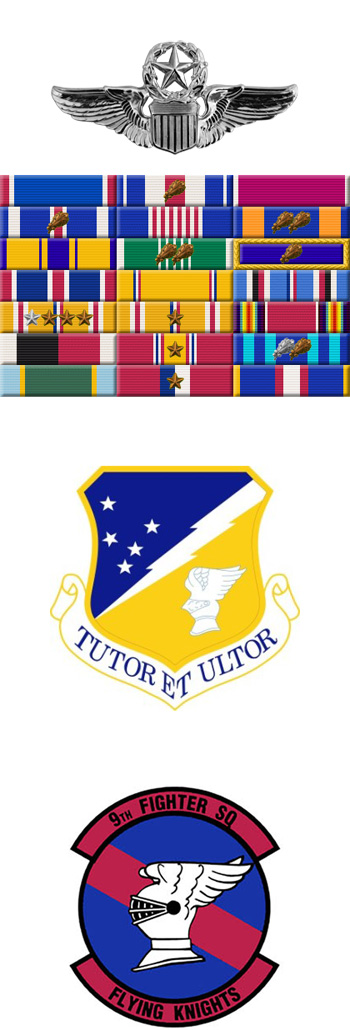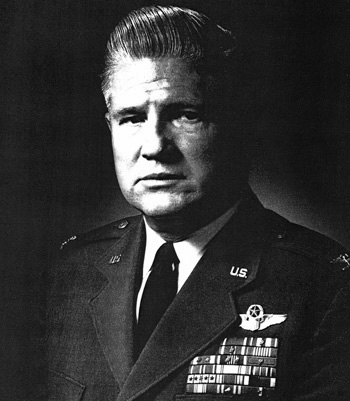
|
James A. Watkins |
 |
|||
| Rank, Service | ||||
Colonel O-6, U.S. Air Force |
||||
| Veteran of: | ||||
|
||||
| Tribute: | ||||
James Watkins was born on August 26, 1920, in Crystal Springs, Mississippi. He enlisted in the Aviation Cadet Program of the U.S. Army Air Corps on February 10, 1941, and was commissioned a 2d Lt and awarded his pilot wings at Craig Field, Alabama, on September 26, 1941. Lt Watkins flew P-39 Airacobra and P-40 Warhawk fighters with the 36th Pursuit Squadron of the 8th Pursuit Group at Mitchel AFB, New York, from September to December 1941, and then flew P-40's and later P-38 Lightning fighters with the 9th Fighter Squadron of the 49th Fighter Group in Australia and New Guinea from February 1942 to August 1943, during which time he was credited with the destruction of 11 enemy aircraft in aerial combat plus 1 probable. His next assignment was as a P-38 instructor pilot with the 332nd Fighter Squadron of the 329th Fighter Group at Santa Ana, California, from October 1943 to March 1944, and then with the 440th Base Unit at Santa Maria Army Air Field, California, from April 1944 to January 1945. Capt Watkins returned to combat in the Pacific in March 1945 with the 49th Fighter Group in the Philippines, and he was credited with destroying another enemy aircraft, for a total of 12 destroyed and 1 probable during World War II, before serving as Commander of the 7th Fighter Squadron of the 49th Fighter Group in Okinawa and then on occupation duty in Japan from July to December 1945. His next assignment was as Deputy Commander of the 49th Fighter Group in Japan from January 1946 to January 1947, and then as Commander of the 7th Fighter Squadron there from January to October 1947. Maj Watkins then served on the staff of the 49th Fighter Group in Japan from October 1947 until he returned to the U.S. in January 1948. He served at March AFB, California, from March to July 1948, and then received an Air Force Institute of Technology assignment to the University of Florida to complete his bachelor's degree in Business Administration from July 1948 to June 1950. Col Watkins next served as an Operations and Test Project Officer with the 3200th Drone Squadron at Eglin AFB, Florida, from June 1950 to July 1951, and then as an Operations Officer in Nuclear Testing with the Special Weapons Center at Kirtland AFB, New Mexico, from July 1951 to December 1952. He served with the 4925th Test Group, also involved in Nuclear Testing, at Kirtland AFB from January 1953 to May 1954, and then as Commander of the 4926th Test Squadron at Kirtland from May 1954 to June 1955. His next assignment was as Inspector General at Headquarters Air Research and Development Command at Baltimore, Maryland, and Andrews AFB, Washington, D.C., from June 1955 to April 1958, followed by service as Director of Operations and then Chief of Operations and Training with the Military Assistance Division of U.S. European Command in France from April 1958 to April 1961. Col Watkins next served as Chief of the Organization and Training Division in the Office of the Deputy Chief of Staff for Mutual Security in the Pentagon from April 1961 to July 1966, and then as Deputy Chief of Staff for Operations and then Vice Commander of the U.S. Logistics Group in Ankara, Turkey, from July 1966 to September 1968. His final assignment was as Chief of the Foreign Military Sales Division with Headquarters U.S. Air Force in the Pentagon from September 1968 until his retirement from the Air Force on February 1, 1970. James Watkins died on August 18, 2008, and was buried at the Dallas-Fort Worth National Cemetery in Dallas, Texas, with his wife Charlcie, who proceeded him in death in 2002. |
||||
|
||||

